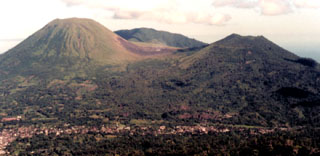Report on Lokon-Empung (Indonesia) — January 1996
Bulletin of the Global Volcanism Network, vol. 21, no. 1 (January 1996)
Managing Editor: Richard Wunderman.
Lokon-Empung (Indonesia) Variable seismicity and minor vapor emissions
Please cite this report as:
Global Volcanism Program, 1996. Report on Lokon-Empung (Indonesia) (Wunderman, R., ed.). Bulletin of the Global Volcanism Network, 21:1. Smithsonian Institution. https://doi.org/10.5479/si.GVP.BGVN199601-266100
Lokon-Empung
Indonesia
1.358°N, 124.792°E; summit elev. 1580 m
All times are local (unless otherwise noted)
Vapor emission was observed during November-December 1995 and whitish-gray plumes rose to 100 m above the active crater. Seismicity during September-October 1995 consisted of 1- 8 A-type events/day. On 1 November there were 46 A-type events recorded, followed by very low seismicity over the next ten days. Activity then increased from 12 November through 31 December, but was highly variable with 4-21 events/day. B-type events remained at 0-8 events/day.
The present activity is located at Tompaluan crater, in the saddle between the peaks of Lokon (1,579 m) and Empung (1,340 m). About 10,000 people evacuated following an explosion in October 1991 accompanied by a pyroclastic flow; the eruption ended in January 1992.
Geological Summary. The Lokong-Empung volcanic complex, rising above the plain of Tondano in North Sulawesi, includes four peaks and an active crater. Lokon, the highest peak, has a flat craterless top. The morphologically younger Empung cone 2 km NE has a 400-m-wide, 150-m-deep crater that erupted last in the 18th century. A ridge extending 3 km WNW from Lokon includes the Tatawiran and Tetempangan peaks. All eruptions since 1829 have originated from Tompaluan, a 150 x 250 m crater in the saddle between Lokon and Empung. These eruptions have primarily produced small-to-moderate ash plumes that sometimes damaged croplands and houses, but lava-dome growth and pyroclastic flows have also occurred.
Information Contacts: Wimpy S. Tjetjep (Director), Volcanological Survey of Indonesia (VSI), Jalan Diponegoro 57, Bandung, Indonesia.

